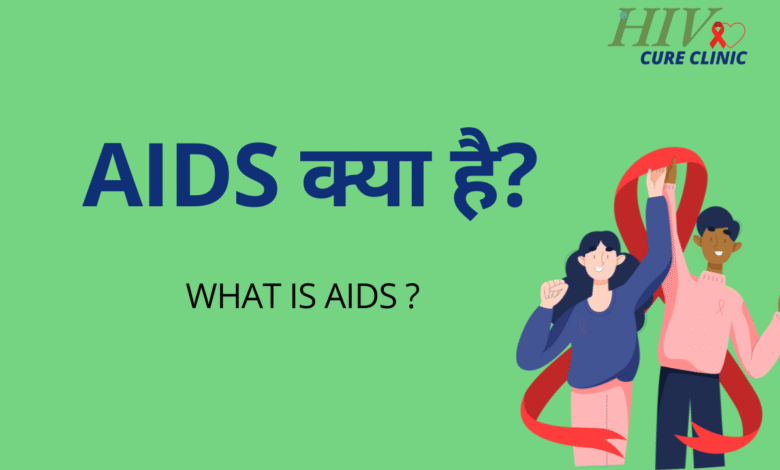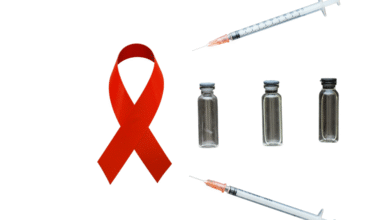एड्स क्या है?

एड्स (AIDS) का पूरा नाम एक्वायर्ड इम्यूनोडेफिशिएंसी सिंड्रोम (Acquired Immunodeficiency Syndrome) है। यह एचआईवी (HIV) संक्रमण का सबसे उन्नत और गंभीर चरण है। जैसा कि हमने पहले देखा, एचआईवी एक वायरस है जो शरीर की प्रतिरक्षा प्रणाली (immune system) पर हमला करता है। जब यह वायरस प्रतिरक्षा प्रणाली को इतना नुकसान पहुंचा देता है कि शरीर सामान्य संक्रमणों और कुछ कैंसर से लड़ने में असमर्थ हो जाता है, तब एड्स की स्थिति उत्पन्न होती है।
सरल शब्दों में कहें तो, एड्स एचआईवी संक्रमण का अंतिम चरण है, जहाँ शरीर की रक्षा प्रणाली पूरी तरह से कमजोर हो जाती है। यह कोई एक बीमारी नहीं है, बल्कि विभिन्न प्रकार के गंभीर संक्रमणों और बीमारियों का एक समूह है जो कमजोर प्रतिरक्षा प्रणाली के कारण उत्पन्न होते हैं।
एड्स कैसे विकसित होता है?
जब कोई व्यक्ति एचआईवी से संक्रमित होता है, तो वायरस धीरे-धीरे शरीर में सीडी4 (CD4) कोशिकाओं को नष्ट करना शुरू कर देता है। ये कोशिकाएं प्रतिरक्षा प्रणाली का एक महत्वपूर्ण हिस्सा हैं और शरीर को संक्रमणों से बचाने में मदद करती हैं। जैसे-जैसे सीडी4 कोशिकाओं की संख्या घटती जाती है, शरीर की रोगों से लड़ने की क्षमता कम होती जाती है।
यदि एचआईवी संक्रमण का इलाज न किया जाए, तो यह कई वर्षों तक बिना किसी गंभीर लक्षण के रह सकता है (अव्यक्त चरण)। इस दौरान भी वायरस सीडी4 कोशिकाओं को नष्ट करता रहता है। जब सीडी4 कोशिकाओं की संख्या एक निश्चित स्तर से नीचे गिर जाती है (आमतौर पर 200 कोशिकाएं प्रति क्यूबिक मिलीमीटर रक्त से कम), या जब व्यक्ति को कुछ विशेष “एड्स-परिभाषित स्थितियां” (AIDS-defining conditions) जैसे कि कपोसी सारकोमा, पीसीपी निमोनिया, या कुछ प्रकार के लिम्फोमा विकसित हो जाते हैं, तो उसे एड्स से ग्रस्त माना जाता है।
यह समझना महत्वपूर्ण है कि हर एचआईवी संक्रमित व्यक्ति को एड्स नहीं होता है। एंटीरेट्रोवायरल थेरेपी (ART) के प्रभावी होने के कारण, आजकल एचआईवी संक्रमित अधिकांश लोग एड्स के चरण तक नहीं पहुंचते हैं। एआरटी वायरस को नियंत्रित करने और सीडी4 कोशिकाओं को बचाने में मदद करती है, जिससे प्रतिरक्षा प्रणाली मजबूत बनी रहती है।
एड्स के लक्षण और संबंधित बीमारियाँ क्या है?
एड्स के लक्षण कमजोर प्रतिरक्षा प्रणाली के कारण होने वाले अवसरवादी संक्रमणों (opportunistic infections) और कैंसर से संबंधित होते हैं। कुछ सामान्य लक्षण और बीमारियाँ जो एड्स से जुड़े होते हैं उनमें शामिल हैं:
- तेजी से वजन कम होना: बिना किसी स्पष्ट कारण के शरीर का वजन तेजी से घटना।
- अत्यधिक थकान: लगातार और असामान्य रूप से थका हुआ महसूस करना।
- बार-बार बुखार और रात में पसीना आना: बिना किसी संक्रमण के बार-बार बुखार आना और रात में अत्यधिक पसीना आना।
- लंबे समय तक दस्त: तीन दिनों से अधिक समय तक रहने वाला दस्त।
- मुंह या जननांगों पर छाले: कैंडिडिआसिस (थ्रश) जैसे फंगल संक्रमण।
- त्वचा पर चकत्ते और घाव: असामान्य त्वचा की स्थिति।
- लिम्फ नोड्स में सूजन: गर्दन, कांख या कमर में ग्रंथियों में लगातार सूजन।
- न्यूरोलॉजिकल समस्याएं: स्मृति हानि, भ्रम, या चलने में कठिनाई।
- गंभीर संक्रमण: जैसे न्यूमोसिस्टिस निमोनिया (PCP), टोक्सोप्लाज्मोसिस, तपेदिक (TB), क्रिप्टोस्पोरिडिओसिस, और साइटोमेगालोवायरस (CMV) संक्रमण।
- कुछ प्रकार के कैंसर: जैसे कपोसी सारकोमा (Kaposi’s Sarcoma), गैर-हॉजकिन लिम्फोमा (Non-Hodgkin Lymphoma), और गर्भाशय ग्रीवा का कैंसर।
एड्स का इलाज और रोकथाम क्या है?
एड्स का कोई इलाज नहीं है, लेकिन एचआईवी का प्रभावी उपचार उपलब्ध है। एंटीरेट्रोवायरल थेरेपी (ART) ही एचआईवी संक्रमण को नियंत्रित करने और एड्स को रोकने का एकमात्र तरीका है। एआरटी दवाओं का एक संयोजन है जो एचआईवी वायरस को बढ़ने से रोकती है, जिससे सीडी4 कोशिकाओं की संख्या बढ़ती है और प्रतिरक्षा प्रणाली मजबूत होती है। नियमित और सही एआरटी से एचआईवी संक्रमित व्यक्ति सामान्य जीवन जी सकता है और एड्स के विकास को रोक सकता है।
एड्स की रोकथाम मूलतः एचआईवी के संचरण को रोकने पर निर्भर करती है:
- सुरक्षित यौन संबंध बनाना (कंडोम का उपयोग)।
- सुइयों और सिरिंज को साझा करने से बचना।
- एचआईवी के लिए नियमित परीक्षण करवाना।
- गर्भवती एचआईवी पॉजिटिव महिलाओं को दवाएं देना ताकि वायरस बच्चे में न फैले।
- प्रेप (PrEP) और पेप (PEP) जैसी निवारक रणनीतियों का उपयोग करना।
एड्स एक गंभीर सार्वजनिक स्वास्थ्य चुनौती है, लेकिन एचआईवी के बारे में जागरूकता, शुरुआती परीक्षण, और प्रभावी एआरटी तक पहुंच से इस बीमारी के प्रभाव को काफी हद तक कम किया जा सकता है।





